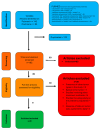Bevacizumab for Vestibular Schwannomas in Neurofibromatosis Type 2: A Systematic Review of Tumor Control and Hearing Preservation
- PMID: 39685944
- PMCID: PMC11642482
- DOI: 10.3390/jcm13237488
Bevacizumab for Vestibular Schwannomas in Neurofibromatosis Type 2: A Systematic Review of Tumor Control and Hearing Preservation
Abstract
Background/Objectives: Vestibular schwannomas (VSs), also called acoustic neuromas, are benign tumors affecting the vestibulocochlear nerve, often leading to hearing loss and balance issues. This condition is particularly challenging in patients with neurofibromatosis type 2 (NF2), where VSs tend to develop bilaterally. Conventional treatments, such as surgery and radiotherapy, although effective, carry risks like hearing loss and nerve damage. Bevacizumab, a VEGF-targeting monoclonal antibody, has emerged as a less invasive treatment option, showing potential for tumor volume reduction and hearing preservation. This systematic review aims to assess the efficacy of bevacizumab in controlling tumor volume, preserving hearing, and identifying associated adverse events. Methods: A comprehensive systematic review was performed using PRISMA guidelines. PubMed and Cochrane Library databases were searched for studies evaluating the effects of bevacizumab on VS, focusing on key outcomes like tumor volume reduction, hearing preservation, and adverse events. Data extraction and quality assessment were independently conducted by two reviewers using the Newcastle-Ottawa Scale. Results: Nine studies involving 176 patients were included. Bevacizumab showed a partial tumor volume reduction (≥20%) in 40% of cases and disease stabilization in 50%, while 10% experienced tumor progression. Hearing outcomes revealed improvement in 36% of patients, stabilization in 46%, and deterioration in 18%. Severe adverse effects, including hypertension and thromboembolic events, occurred in 13% of patients, while 18% reported no side effects. Tumor regrowth was observed in some patients after treatment discontinuation, emphasizing the need for long-term monitoring. Conclusions: Bevacizumab demonstrates effectiveness in managing VS, particularly in NF2 patients, by reducing tumor size and preserving hearing in a substantial proportion of cases. However, the variability in patient response and the risk of adverse events underscore the need for individualized treatment approaches and further research, including randomized controlled trials, to optimize its clinical application.
Keywords: adverse effects; bevacizumab; hearing preservation; neurofibromatosis type 2; tumor volume reduction; vestibular schwannoma.
Conflict of interest statement
The authors declare no conflicts of interest.
Figures
References
-
- Evans D.G., Huson S.M., Donnai D., Neary W., Blair V., Teare D., Newton V., Strachan T., Ramsden R., Harris R. A Genetic Study of Type 2 Neurofibromatosis in the United Kingdom. I. Prevalence, Mutation Rate, Fitness, and Confirmation of Maternal Transmission Effect on Severity. J. Med. Genet. 1992;29:841–846. doi: 10.1136/jmg.29.12.841. - DOI - PMC - PubMed
-
- Evans D.G.R., Moran A., King A., Saeed S., Gurusinghe N., Ramsden R. Incidence of Vestibular Schwannoma and Neurofibromatosis 2 in the North West of England over a 10-Year Period: Higher Incidence than Previously Thought. Otol. Neurotol. 2005;26:93–97. doi: 10.1097/00129492-200501000-00016. - DOI - PubMed
-
- Samii M., Matthies C., Tatagiba M. Management of Vestibular Schwannomas (Acoustic Neuromas): Auditory and Facial Nerve Function after Resection of 120 Vestibular Schwannomas in Patients with Neurofibromatosis 2. Neurosurgery. 1997;40:696–705; discussion 705–706. doi: 10.1097/00006123-199704000-00007. - DOI - PubMed
Publication types
LinkOut - more resources
Full Text Sources
Research Materials
Miscellaneous


